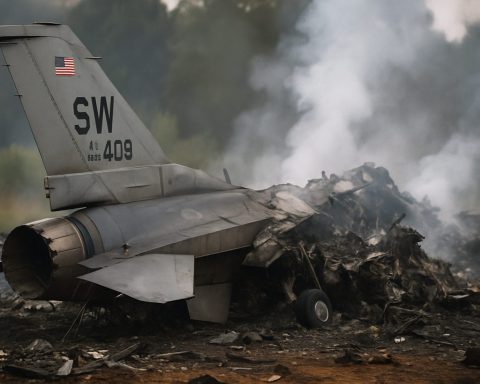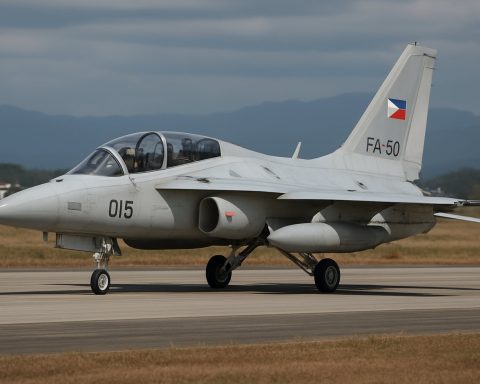- The Dassault Rafale is a symbol of French innovation and a standout in fighter jet design, outperforming competitors like the Eurofighter Typhoon.
- Originating from the Cold War’s end, France pursued the Rafale independently for strategic autonomy, capable of land and naval operations.
- The Rafale features a canard delta-wing design, AESA radar, and twin Snecma M88 engines, achieving Mach 1.8 and 9 g maneuvers.
- Initially overlooked internationally, the Rafale gained global traction, with notable orders from nations like Egypt, India, and the UAE.
- The Rafale has proven its combat effectiveness in conflicts including Libya and Mali, enhancing its operational reputation.
- Facing global supply chain challenges, the Rafale continues evolving and expanding production to meet international demand.
In a world of sleek fighter jets slicing through endless blue skies, the Dassault Rafale stands out not just as a marvel of engineering, but as a symbol of French tenacity and innovation. Blazing past contenders like the Eurofighter Typhoon and the SAAB JAS-39 Gripen, the Rafale swoops in with a unique blend of agility, versatility, and sheer power.
Genesis of a Legend
The Rafale, meaning “burst of fire” in its native tongue, traces its fiery origins back to the clattering end of the Cold War. As European nations squabbled over design and functionality for a new fighter jet consortium, France boldly pursued its own path. The desire for “strategic autonomy” and an aircraft that could perform both land and naval roles led to the birth of the Rafale, a solo venture amidst a sea of allied projects. Conceived from Dassault’s earlier ACX project, this jet emerged from a prototype unveiled in 1985—a testament to vision and determination.
The Rafale’s Distinct Craftsmanship
The Rafale’s canard delta-wing configuration, a signature silhouette, coupled with its active electronically scanned array (AESA) radar and infrared sensors, allows it to seize targets from afar with hawk-like precision. Its twin Snecma M88 engines roar with a non-polluting ferocity, achieving speeds of Mach 1.8 while maintaining agility over 9 g maneuvers. Silent yet deadly, the Rafale is a modern echo of Claude Chappe’s optical telegraph—powerful and distinctly French.
From Underdog to Global Contender
Once overshadowed in the world of military aviation, the Rafale was slow to attract international buyers. Yet, as shifting global alliances and strategic interests realigned, this multirole aircraft found eager homes in air forces across Egypt, India, and beyond. An order from the UAE in 2021, marking a purchase of 80 units, underscored its newfound acclaim and strategic value.
A Proven Combatant
The sleek Rafale has proven its mettle in the crucible of war—from conducting precise airstrikes in Libya to braving the deserts of Mali. Recent engagements, including successful interceptions over complex terrains, have only burnished its operational credibility.
A Robust Future
As production ramps up to meet soaring demand, Dassault’s famed creation faces challenges not of its making—in particular, the modern complexities of global supply chains. Yet, with French resolve, the Rafale continues to evolve and assert its dominance, with plans of increased manufacturing to serve its accolades in aerial battlefields around the globe.
France’s Rafale captures the essence of its nation: innovative, fiercely independent, and wonderfully adaptable. In the arena of European fighter jets, the Dassault Rafale invariably propels itself forward on the wings of its unrivaled prowess, remaining unmatched in versatility and strength. Whether crisscrossing the skies over Paris or the far reaches of the Indo-Pacific, the Rafale’s legacy is assured—an uncompromising sentinel of the skies, crafted with precision, flown with pride.
Why the Dassault Rafale Dominates the Skies: Secrets of Innovation and Performance
Unraveling the Rafale Magic: Insights into a Top-Tier Fighter Jet
The Dassault Rafale is more than just a fighter jet—it’s a testament to French engineering excellence and strategic foresight. Here’s an expanded look into the Rafale’s world, exploring details and offering insights not fully covered before.
Technical Marvel: Features and Innovations
1. Advanced Aerodynamics:
– The Rafale’s canard delta wing design not only contributes to its agile performance but also optimizes lift, drag, and stability, vital for executing complex maneuvers.
2. State-of-the-Art Avionics:
– Equipped with the RBE2 radar system, the first European fighter with an active electronically scanned array (AESA) radar, it allows simultaneous target tracking and surveillance over extended ranges.
3. Multi-Role Capabilities:
– The aircraft can switch roles seamlessly, thanks to its modular aeronautics, carrying out air supremacy, interdiction, reconnaissance, and nuclear deterrence missions with ease.
4. Eco-Friendly Powerplant:
– The Snecma M88 engines are designed to offer high thrust-to-weight ratios while reducing carbon emissions, reflecting a focus on sustainable aviation solutions.
5. Stealth Features:
– While not primarily known for stealth, the Rafale incorporates composite materials and design strategies to reduce its radar cross-section slightly, balancing speed and operational capability.
Real-World Applications and Success Stories
1. Global Deployments:
– The Rafale has proven its global applicability, with deployments ranging from naval operations off aircraft carriers to high-altitude air superiority missions.
2. Combat Effectiveness:
– Demonstrated impressive performance in varied environments, such as deserts and urban settings, offering insights into its adaptability and combat readiness.
3. International Markets and Demand:
– Countries like India have incorporated the Rafale into their strategic defense plans, emphasizing the jet’s value in addressing modern military threats.
Navigating Challenges and Market Trends
1. Global Supply Chain Complications:
– Despite international acclaim, the Rafale faces challenges due to fluctuating supply chains, necessitating robust logistical strategies for sustained production.
2. The Competitive Landscape:
– Competing against formidable jets like the Eurofighter Typhoon and Lockheed Martin F-35, the Rafale must continue to innovate to sustain its market share.
3. Future Upgrades:
– Initiatives are underway to integrate more autonomous capabilities and next-gen sensors, ensuring the Rafale remains at the forefront of defense technology.
Pros and Cons: An In-Depth Evaluation
– Pros:
– Unmatched versatility allows it to perform multiple roles with efficiency.
– Advanced radar and sensor systems improve threat detection and response times.
– Exceptional agility and speed in combat scenarios.
– Cons:
– Higher acquisition and maintenance costs compared to some competitors.
– Limited stealth features could be seen as a disadvantage in high-tech warfare domains.
Conclusion: Actionable Insights for Defense Enthusiasts
To tap into the Rafale’s full potential:
– Countries should consider strategic partnerships and technology transfers, enhancing both operational capacity and regional security.
– Leverage its multi-role capabilities by integrating customized electronic warfare systems based on specific threat environments.
For more information on the Rafale’s exceptional features, visit the official website of Dassault Aviation.
In summary, the Dassault Rafale is poised to remain a leader in the skies, combining historical innovation with modern warfare needs. Whether evaluating it for national defense procurement or understanding its combat role, the Rafale offers insights into the future of air dominance.







